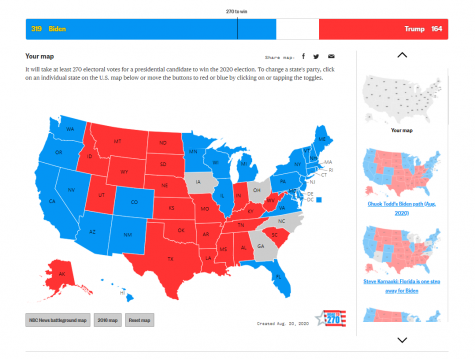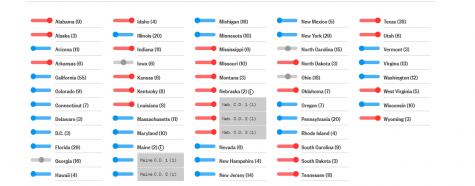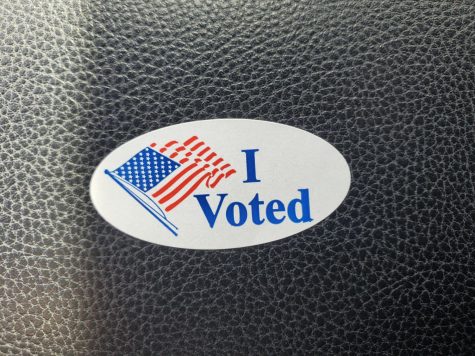State of the race: What polling averages look like
August 21, 2020
The path to victory for Donald Trump’s reelection looks dire, according to the RCP polling averages. Biden is at 319 electoral votes and Trump is at 164 votes after a final count.

For reference, any state that is considered a tossup in this article is within four points in the RCP polling average or has a senate race that is within four points. Of course, there are exceptions to this rule, such as Montana. Montana is almost always going to be Republican in the Presidential race, but the Republican candidate is only two points ahead. Steve Bullock, the Democratic candidate, is the governor of Montana and is looked upon favorably by Montana’s residents. This cannot reasonably be considered a tossup because Bullock is not a typical Democrat, and Montana is a heavily Republican state.
If a senate race is lopsided and the presidential polling is close, it’s not considered a tossup. While this methodology is not universal, it should give us a snapshot into how the race could go.
Another reminder is that this is only a snapshot in time. We can’t predict what will happen in 75 days, but we can make an inference today about what could happen.
The state of Florida voted for George W. Bush by a margin of 537 votes in 2000, voted for Bush in 2004, for Obama twice in 2008 and 2012, and for Trump in 2016. With such a volatile and fickle history, who would ever consider Florida to go one way or the other?
The reason why Florida is called for Biden is because his lead has been incredibly consistent, and usually outside the margin of error — the area of statistical uncertainty (the margin of error is where polls go to die, because it can go either way). In the RCP polling average in Florida, Biden is winning by five points, and he has been winning in that average for several months.

Arizona is also currently swinging towards Biden. While Biden is only two points ahead in the RCP average, the Republican incumbent, Martha McSally, is losing by 7.4 points in that average, and the polls usually have the Democratic candidate winning outside the margin of error.
Georgia is a fascinating race as well. Both of Georgia’s senate seats are up for election, and the presidential race is close. Trump is leading in the RCP polling average by 1.1 points. In one of Georgia’ senate races, David Perdue, the Republican incumbent is only winning by four points over the Democratic candidate, Jon Ossoff. In the special senate election race, Republican Kelly Loeffler is winning by 4.3 points. This race is a tossup.
North Carolina is a state in a similar situation. In the North Carolina senate race, the Democratic candidate is 3.5 points ahead. In the RCP polling average, Trump is 0.6 points ahead. This is most certainly a tossup.
Ohio is a tossup because Biden is only up by 2.3 points in the average, and it really could go either way. It’s a hard race to call because of how Republican it is (it has a Republican state house and state senate and a Republican governor).
Iowa is a traditionally Republican state where the senate race is a difference of 0.3 points in the RCP average towards the Democratic candidate, whereas the presidential race is only a difference of 1.7 points in favor of Trump. This is a tossup.
Michigan, Wisconsin, and Pennsylvania are all outside the margin of error in most polls, so Trump may not win any of these states today.
Today, this isn’t a close race, but we need to understand that it can tighten up between now and November 3rd, and nothing is certain. Again, this is only a snapshot in time – it will almost certainly be different on Election Day. We will have to wait to see what happens in the days leading up to November 3.
__
For more information or news tips, or if you see an error in this story or have any compliments or concerns, contact [email protected].






















